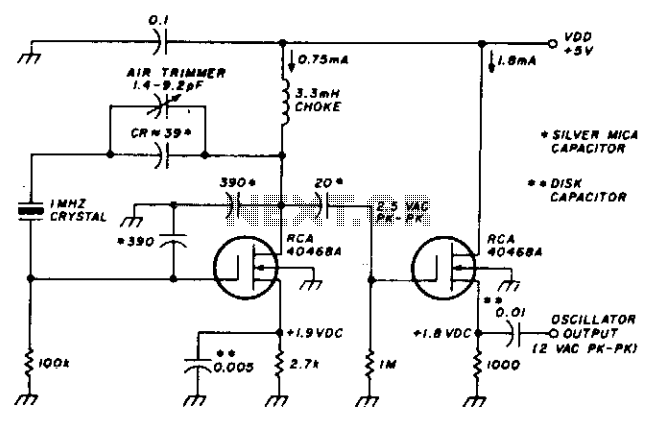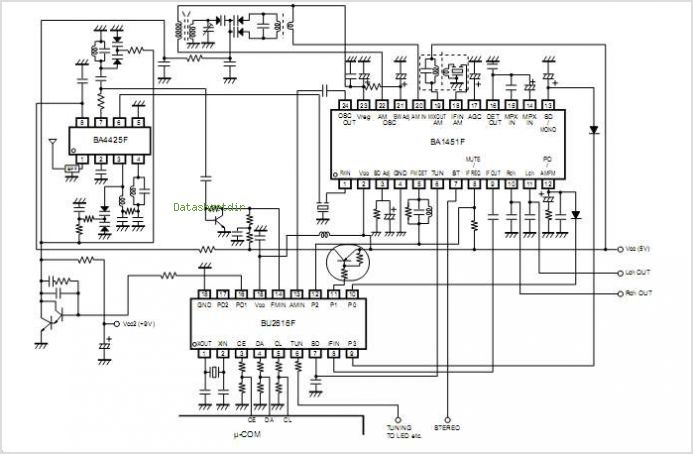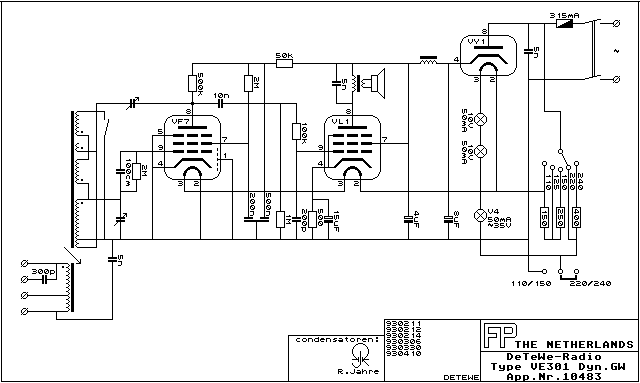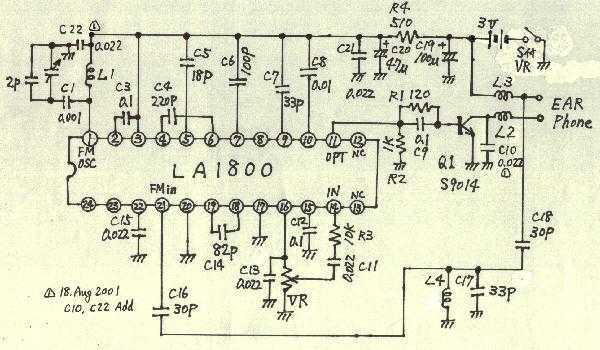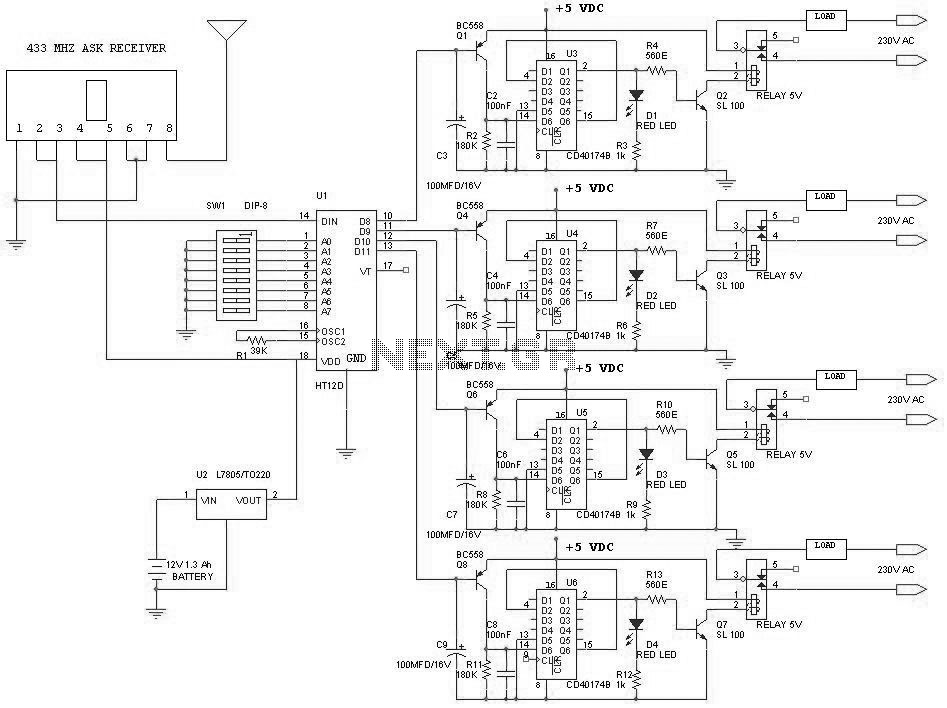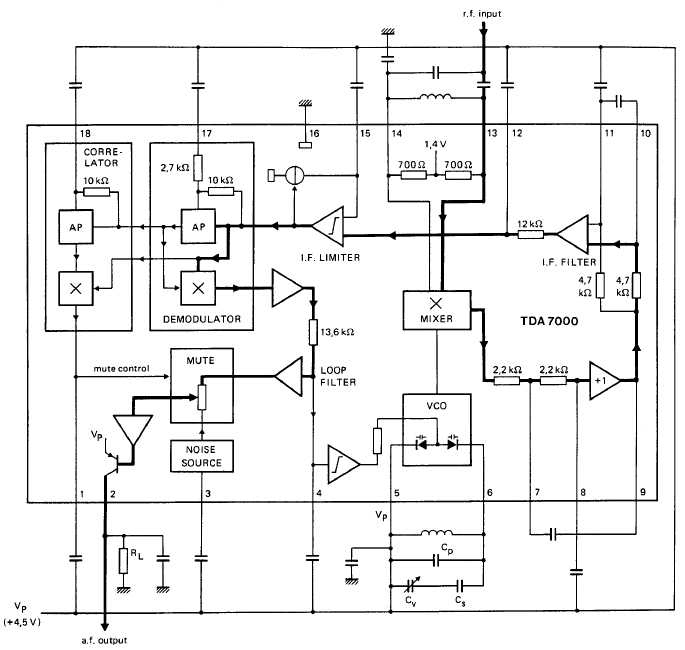
Crystal Radio

The original BFO, a compact EICO 330 solid-state signal generator, effectively received a variety of distant longwave (LW) beacons. In late 2004 to early 2005, a new One-Active Device (1-AD) contest was introduced to complement the Crystal Set DX contest. Steve McDonald suggested applying the BFO concept to broadcast band (BCB) reception for the 1-AD contest. Utilizing the 1-AD contest's limitation of one active device (one tube or one transistor), a simple one-JFET Hartley BFO was planned as a proof-of-concept, which ultimately sufficed without further development. The BFO connects to the crystal set by attaching a clip lead to the OUT post and loosely wrapping it around the crystal set's antenna lead-in wire, with no ground connection between the BFO and the crystal set. The coil and tuning capacitor should be of high Q to maintain sharp oscillations. The BFO demonstrates short-term frequency stability despite lacking voltage regulation, with a warm-up time of 10 to 15 seconds. Tuning into a station and turning off the BFO for an hour allows the set to return to zero beat quickly. The BFO draws approximately 0.3 mA, contributing to its frequency stability. The circuit includes a 1-MPF 102 JFET BFO, a 1000 pF variable capacitor connected across the BFO's tuning capacitor for low-frequency operation, and a double-tuned LF crystal set. Sound-powered phones and a matching transformer are also utilized. The BFO injects an exalted carrier for AM signal reception or an audible beat note for CW reception. The crystal set features a series-tuned front-end and a parallel-tuned secondary detector section, which has proven effective in receiving over 80 LW beacons across the Pacific region. The tuning capacitor's plates vibrate, producing classic frequency modulation around the zero beat. Enhanced selectivity minimizes the need for a wave trap, though some splatter occurs from certain stations. Local stations can pervade the spectrum, affecting audio quality, especially when the BFO is adjusted for on-channel reception. The BFO generates harmonic content, causing strong signals to appear at multiples of the tuned frequency, complicating reception. Additionally, interference from shortwave signals can overwhelm the BFO signal, necessitating careful tuning. The ideal setup would include a digital readout radio with disarmed AGC for better verification of program content.
The BFO circuit operates as a simple yet effective radio frequency generator, utilizing a single JFET transistor in a Hartley configuration. The transistor serves as the active device, generating oscillations at a frequency determined by the inductance of the coil and the capacitance of the tuning capacitor. The high Q factor of the components is crucial for maintaining stable oscillations and minimizing frequency drift. The BFO's output is coupled to the crystal set's antenna through a loose coupling method to prevent loading effects that could degrade performance.
The crystal set itself is designed with a series-tuned front-end that selectively amplifies incoming signals, while the parallel-tuned secondary section acts as a detector to demodulate the AM signals. This configuration enhances the overall selectivity and sensitivity of the receiver, allowing it to pick up distant LW beacons effectively. The integration of sound-powered phones ensures that the audio output is clear and intelligible, while the matching transformer aids in impedance matching for optimal power transfer.
The tuning process requires precision, particularly when achieving zero beat with local stations. The BFO's sensitivity to tuning adjustments means that slight changes can significantly impact the reception quality. This characteristic necessitates a careful approach to tuning, often requiring the operator to utilize body capacitance as a vernier adjustment for fine-tuning.
Overall, the BFO and crystal set combination represents a practical and innovative approach to amateur radio reception, demonstrating the potential of simple circuits to achieve effective results in the field of radio communications. The design emphasizes the importance of component quality, circuit stability, and the operator's skill in tuning for optimal performance.My original BFO, a small EICO 330 solid state signal generator, served well to bring in a variety of distant LW beacons. In late-2004/early-2005, a new One-Active Device (1-AD) contest to complement the Crystal Set DX contest was announced.
Steve McDonald suggested that I should try applying the BFO idea to BCB reception in the 1-AD contest. Beca use of the 1-AD Contest limit of one active device 1 tube or 1 transistor - I planned to replace the EICO with a simple, one-JFET Hartley BFO as "proof-of-concept" and then to build from there. As it turned out, there was little need to go beyond this basic one-JFET set. The BFO is connected to the crystal set by attaching a clip lead to the OUT post and loosely wrapping the lead around the crystal set`s antenna lead-in wire.
The BFO and crystal set grounds are not connected. The coil and tuning capacitor should be high Q to keep the oscillations sharp as possible. The BFO is very frequency-stable in the short term in spite of there being no supply voltage regulation provisions. I planned to address voltage regulation in Phase II, but never got that far. `Warm-up time` is 10 to 15 seconds. I can tune in a station, turn off the BFO for an hour or so, then turn the set back on to hear a high-pitched whistle descend exactly to zero beat in a matter of seconds.
One thing working for frequency stability is the low current draw, only about 0. 3 mA. At left is the 1-MPF 102 JFET BFO. In center is a 1000 pF variable capacitor shunted across the BFO`s tuning capacitor to get to low frequencies. (The BFO was originally designed to cover the BCB. ) The two-dial unit to the right is a double-tuned LF crystal set. Also used but not shown are sound powered phones and matching transformer. A clip lead from the BFO output is wrapped around the crystal set`s antenna lead-in for injection. The BFO provides exalted carrier for AM signal reception or an audible beat note for CW reception. The complete circuit is shown below: The crystal set itself is a series-tuned front-end loosely coupled to a parallel-tuned secondary detector section.
Of several designs I tried, this one seemed to work best. This set has received over 80 LW beacons covering the Pacific area, from Samoa to the Aleutians, west to tuning capacitor is lightly rapped, causing the plates to vibrate. This is classic frequency modulation about the zero beat. Equally significant is greatly enhanced selectivity - so much so a wave trap is rarely needed. There is splatter on the baddest actors, but that`s the station, not the set. The strongest (non-splattering) local stations were noted to `pervade` the spectrum several tens of kilohertz to either side of their center frequencies.
This is because the set, good as it is, has only so much selectivity. You can tell when an off-channel local is present because its audio quality is not affected by re-adjusting the BFO. As described below, on-channel audio quality is greatly affected by tweaking the BFO exactly to its frequency.
The simple BFO does have harmonic content. The BFO is going to exalt strong signals at 2x, 3x, 4x, etc. the frequency you`re tuned to. For me, this means local stations at 1080, 1500 and 1540 show up at 540, 750 and 770 kHz and make listening to these frequencies difficult. 2. 5 MHz WWVH ties up 1250 kHz - I also hear them on 625 kHz. A far greater threat especially for the MRL 39 set - is all the short wave (SW) going on, especially in the evening.
Fortunately, my location is in the SW boonies. A spotter radio is near-useless - dead as a doornail. Front-end overload by the BFO signal causes automatic gain control (AGC) clamping in the spotter. Turning the BFO off brings the spotter back to life. But you can`t listen to both simultaneously to verify identical program content. It`s not that difficult without the spotter. Tune to a known station and `count channels` to either side by noting the ascending/descending pitch squeal to the next zero beat. The ideal spotter would be a digital readout radio whose AGC can be disarmed. The BFO requires some deft tuning to get exact zero beat. At the top end, this is nearly impossible - so I tune as close as I can and then zero-beat by judiciously positioning my left hand near the BFO - a hand capacitance vernier.
Because BFO tuning is so touchy, I chose the 🔗 External reference
The BFO circuit operates as a simple yet effective radio frequency generator, utilizing a single JFET transistor in a Hartley configuration. The transistor serves as the active device, generating oscillations at a frequency determined by the inductance of the coil and the capacitance of the tuning capacitor. The high Q factor of the components is crucial for maintaining stable oscillations and minimizing frequency drift. The BFO's output is coupled to the crystal set's antenna through a loose coupling method to prevent loading effects that could degrade performance.
The crystal set itself is designed with a series-tuned front-end that selectively amplifies incoming signals, while the parallel-tuned secondary section acts as a detector to demodulate the AM signals. This configuration enhances the overall selectivity and sensitivity of the receiver, allowing it to pick up distant LW beacons effectively. The integration of sound-powered phones ensures that the audio output is clear and intelligible, while the matching transformer aids in impedance matching for optimal power transfer.
The tuning process requires precision, particularly when achieving zero beat with local stations. The BFO's sensitivity to tuning adjustments means that slight changes can significantly impact the reception quality. This characteristic necessitates a careful approach to tuning, often requiring the operator to utilize body capacitance as a vernier adjustment for fine-tuning.
Overall, the BFO and crystal set combination represents a practical and innovative approach to amateur radio reception, demonstrating the potential of simple circuits to achieve effective results in the field of radio communications. The design emphasizes the importance of component quality, circuit stability, and the operator's skill in tuning for optimal performance.My original BFO, a small EICO 330 solid state signal generator, served well to bring in a variety of distant LW beacons. In late-2004/early-2005, a new One-Active Device (1-AD) contest to complement the Crystal Set DX contest was announced.
Steve McDonald suggested that I should try applying the BFO idea to BCB reception in the 1-AD contest. Beca use of the 1-AD Contest limit of one active device 1 tube or 1 transistor - I planned to replace the EICO with a simple, one-JFET Hartley BFO as "proof-of-concept" and then to build from there. As it turned out, there was little need to go beyond this basic one-JFET set. The BFO is connected to the crystal set by attaching a clip lead to the OUT post and loosely wrapping the lead around the crystal set`s antenna lead-in wire.
The BFO and crystal set grounds are not connected. The coil and tuning capacitor should be high Q to keep the oscillations sharp as possible. The BFO is very frequency-stable in the short term in spite of there being no supply voltage regulation provisions. I planned to address voltage regulation in Phase II, but never got that far. `Warm-up time` is 10 to 15 seconds. I can tune in a station, turn off the BFO for an hour or so, then turn the set back on to hear a high-pitched whistle descend exactly to zero beat in a matter of seconds.
One thing working for frequency stability is the low current draw, only about 0. 3 mA. At left is the 1-MPF 102 JFET BFO. In center is a 1000 pF variable capacitor shunted across the BFO`s tuning capacitor to get to low frequencies. (The BFO was originally designed to cover the BCB. ) The two-dial unit to the right is a double-tuned LF crystal set. Also used but not shown are sound powered phones and matching transformer. A clip lead from the BFO output is wrapped around the crystal set`s antenna lead-in for injection. The BFO provides exalted carrier for AM signal reception or an audible beat note for CW reception. The complete circuit is shown below: The crystal set itself is a series-tuned front-end loosely coupled to a parallel-tuned secondary detector section.
Of several designs I tried, this one seemed to work best. This set has received over 80 LW beacons covering the Pacific area, from Samoa to the Aleutians, west to tuning capacitor is lightly rapped, causing the plates to vibrate. This is classic frequency modulation about the zero beat. Equally significant is greatly enhanced selectivity - so much so a wave trap is rarely needed. There is splatter on the baddest actors, but that`s the station, not the set. The strongest (non-splattering) local stations were noted to `pervade` the spectrum several tens of kilohertz to either side of their center frequencies.
This is because the set, good as it is, has only so much selectivity. You can tell when an off-channel local is present because its audio quality is not affected by re-adjusting the BFO. As described below, on-channel audio quality is greatly affected by tweaking the BFO exactly to its frequency.
The simple BFO does have harmonic content. The BFO is going to exalt strong signals at 2x, 3x, 4x, etc. the frequency you`re tuned to. For me, this means local stations at 1080, 1500 and 1540 show up at 540, 750 and 770 kHz and make listening to these frequencies difficult. 2. 5 MHz WWVH ties up 1250 kHz - I also hear them on 625 kHz. A far greater threat especially for the MRL 39 set - is all the short wave (SW) going on, especially in the evening.
Fortunately, my location is in the SW boonies. A spotter radio is near-useless - dead as a doornail. Front-end overload by the BFO signal causes automatic gain control (AGC) clamping in the spotter. Turning the BFO off brings the spotter back to life. But you can`t listen to both simultaneously to verify identical program content. It`s not that difficult without the spotter. Tune to a known station and `count channels` to either side by noting the ascending/descending pitch squeal to the next zero beat. The ideal spotter would be a digital readout radio whose AGC can be disarmed. The BFO requires some deft tuning to get exact zero beat. At the top end, this is nearly impossible - so I tune as close as I can and then zero-beat by judiciously positioning my left hand near the BFO - a hand capacitance vernier.
Because BFO tuning is so touchy, I chose the 🔗 External reference
